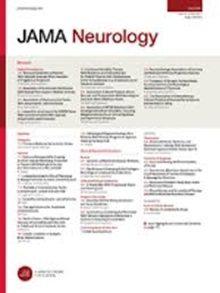Plasma Phosphorylated Tau 217 to Identify Preclinical Alzheimer Disease.
IF 21.3
1区 医学
Q1 CLINICAL NEUROLOGY
引用次数: 0
Abstract
Importance Advances in Alzheimer disease (AD) have shifted research focus to earlier disease stages, necessitating more scalable approaches to identify cognitively unimpaired individuals with amyloid β (Aβ) pathology. Objective To assess the utility of plasma phosphorylated tau 217 (p-tau217) for classifying Aβ status in cognitively unimpaired individuals, both as a stand-alone test and in a 2-step approach where positive plasma results were confirmed using a second modality (Aβ positron emission tomography [PET] or cerebrospinal fluid [CSF]). Design, Setting, and Participants This cross-sectional cohort study used data collected between June 2009 and March 2024. We included 2916 cognitively unimpaired participants from 12 international independent observational cohorts in the US, Europe, Australia, and Canada with available plasma p-tau217 levels and CSF or PET Aβ biomarkers. Performance comparisons between mass spectrometry and immunoassay-based p-tau217 measurements were also performed (n = 964). Exposures Plasma p-tau217 levels measured by immunoassay. Main Outcome and Measures Aβ status, determined by CSF or Aβ PET biomarkers. Results Participants had a mean (SD) age of 66.9 (9.9) years; 971 (33.3%) were Aβ positive by either CSF or PET, 1667 (57.2%) were women, and 1108 (38.1%) carried at least 1 APOE ε4 allele. As a stand-alone test, plasma p-tau217 achieved a positive predictive value (PPV) of 79% (95% CI, 74-84) and an overall accuracy of 81% (95% CI, 80-82). In a 2-step workflow, the PPV and accuracy significantly increased to 91% (95% CI, 86-95). While this approach required screening of 677 individuals with plasma p-tau217 to identify 100 Aβ-positive individuals, compared to 536 participants when using PET alone, it reduced the need for PET testing to 124. Immunoassays demonstrated comparable PPVs to mass spectrometry (80% [95% CI, 74-86] vs 85% [95% CI, 81-90]; P = .12) but significantly lower overall accuracy (82% [95% CI, 79-84]% vs 88 [95% CI, 86-90]; P < .001) and true Aβ-positive detection rate (49% [95% CI, 43-55] vs 69% [95% CI, 64-75]; P < .001). Conclusions and Relevance The findings highlight the potential of plasma p-tau217 as a stand-alone test-or when used in a sequential 2-step approach alongside PET or CSF testing-as a cost-effective, scalable, and minimally burdensome strategy for identifying preclinical AD. Tailored screening workflows that incorporate p-tau217 can improve efficiency in participant selection for preclinical AD trials and, in the future, help guide access to disease-modifying treatments.血浆磷酸化Tau 217识别临床前阿尔茨海默病
阿尔茨海默病(AD)的进展已将研究重点转移到早期疾病阶段,需要更可扩展的方法来识别具有淀粉样蛋白β (Aβ)病理的认知未受损个体。目的评估血浆磷酸化tau217 (p-tau217)在认知功能未受损个体中对a β状态进行分类的效用,既可以作为独立测试,也可以采用两步方法,其中使用第二种方式(a β正电子发射断层扫描[PET]或脑脊液[CSF])确认血浆阳性结果。设计、环境和参与者本横断面队列研究使用2009年6月至2024年3月收集的数据。我们从美国、欧洲、澳大利亚和加拿大的12个国际独立观察队列中纳入了2916名认知功能正常的参与者,这些参与者具有血浆p-tau217水平和CSF或PET Aβ生物标志物。还进行了质谱法和基于免疫分析法的p-tau217测量之间的性能比较(n = 964)。免疫分析法测定血浆p-tau217水平。主要结局和测量:Aβ状态,由CSF或Aβ PET生物标志物确定。结果参与者的平均(SD)年龄为66.9(9.9)岁;971例(33.3%)经CSF或PET检测为Aβ阳性,1667例(57.2%)为女性,1108例(38.1%)携带至少1个APOE ε4等位基因。作为一项独立检测,血浆p-tau217的阳性预测值(PPV)为79% (95% CI, 74-84),总体准确率为81% (95% CI, 80-82)。在两步工作流程中,PPV和准确性显著提高到91% (95% CI, 86-95)。虽然这种方法需要筛选677个血浆p-tau217个体,以确定100个a β阳性个体,而单独使用PET时需要536个参与者,但它将PET测试的需求减少到124个。免疫测定显示PPVs与质谱相当(80% [95% CI, 74-86] vs 85% [95% CI, 81-90]; P =。12),但总体准确率显著降低(82% [95% CI, 79-84]% vs 88% [95% CI, 86-90]; P <。a β真阳性检出率(49% [95% CI, 43-55] vs 69% [95% CI, 64-75]; P < .001)。结论和相关性研究结果强调了血浆p-tau217作为一种独立测试的潜力,或者当与PET或CSF测试一起使用连续两步方法时,作为一种成本效益高、可扩展且负担最小的临床前AD识别策略。结合p-tau217的定制筛选工作流程可以提高临床前阿尔茨海默病试验参与者选择的效率,并在未来帮助指导获得改善疾病的治疗。
本文章由计算机程序翻译,如有差异,请以英文原文为准。
求助全文
约1分钟内获得全文
求助全文
来源期刊

JAMA neurology
CLINICAL NEUROLOGY-
CiteScore
41.90
自引率
1.70%
发文量
250
期刊介绍:
JAMA Neurology is an international peer-reviewed journal for physicians caring for people with neurologic disorders and those interested in the structure and function of the normal and diseased nervous system. The Archives of Neurology & Psychiatry began publication in 1919 and, in 1959, became 2 separate journals: Archives of Neurology and Archives of General Psychiatry. In 2013, their names changed to JAMA Neurology and JAMA Psychiatry, respectively. JAMA Neurology is a member of the JAMA Network, a consortium of peer-reviewed, general medical and specialty publications.
 求助内容:
求助内容: 应助结果提醒方式:
应助结果提醒方式:


